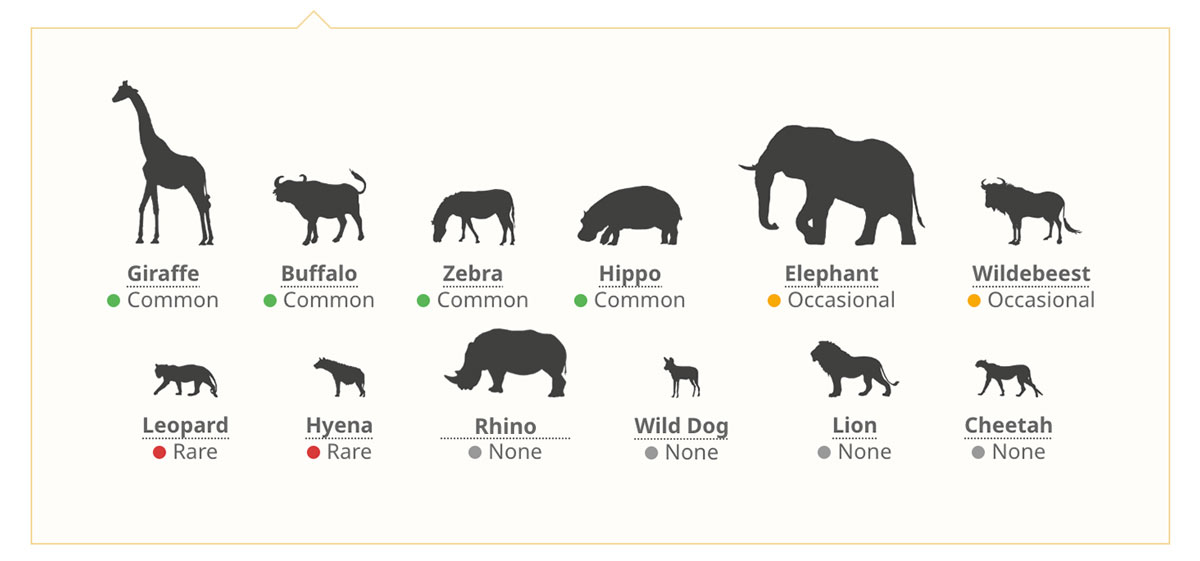Wildlife in Arusha National Park, compared to the other major parks in Tanzania, is a little bit underwhelming. Nevertheless, Arusha National Park feels like a hidden pocket of the wild, where misty forests meet open grasslands and sparkling lakes. It’s not the biggest park out there, but its mix of habitats draws in a surprising array of animals—over 50 mammal species, hundreds of birds, and plenty of reptiles that call this place home. You might spot a family of monkeys swinging through the trees one minute and a herd of zebras grazing the next, all against the backdrop of Mount Meru. What makes it special is how up-close it all feels, especially on foot or by canoe, letting you catch the quiet rustle of life in the bush.
 Abundant Wildlife
Abundant Wildlife
These are the stars you can almost count on seeing without much effort—they’re everywhere, going about their day in plain sight. Blue monkeys chatter noisily in the forest branches, their sleek gray fur blending with the leaves as they leap from tree to tree. Giraffes tower over the grasslands, nibbling acacia leaves with those long necks, often in groups that stretch across the horizon. Zebras stripe the plains in black-and-white herds, kicking up dust as they trot near the Momella Lakes. Warthogs root around in the dirt with their quirky upright trot, and dik-diks—the tiny antelopes no bigger than a house cat—dart through the underbrush like living shadows. Waterbucks hang out by the water’s edge, their shaggy coats damp from a quick drink, while Cape buffaloes lumber in solid bunches, their curved horns like helmets in the sun.
Common animals to see
A bit shyer than the abundants, but still regulars on most visits, these animals pop up often enough to make your heart skip. Black-and-white colobus monkeys lounge high in the canopy, their fluffy tails like flags in the wind, grooming each other with lazy flicks. Hippos grunt and yawn from the shallow lakes, half-submerged like boulders with pinkish skin. Bushbucks slip through the thickets, their reddish coats flashing between ferns, and impalas bound in graceful leaps across open spots. You’ll hear olive baboons before you see them, their whoops echoing as troops forage for fruits and roots.
Occasional wild animals
These guys keep you guessing—they show up now and then, rewarding patient eyes and early starts. Elephants wander in small family groups, their massive ears flapping like sails as they munch on bark near the crater edges, though they’re not as thick here as in bigger parks. Spotted hyenas slink through the dusk, their spotted coats merging with the fading light, scavenging or hunting in pairs. Wildebeests join the grazers on the plains sometimes, their beards swaying as they chew grass, adding to the mini-Serengeti vibe.
Rare animals to spot
The thrill-seekers’ prizes, these elusive creatures demand luck and sharp guides to track down. Leopards melt into the night, their rosettes camouflaged against dappled shadows in the trees—spot one draped over a branch at dawn, and you’ve hit the jackpot. Harvey’s red duikers, those pint-sized forest antelopes with reddish fur and tiny spikes for horns, ghost through the undergrowth so quietly you might miss them entirely. Suni antelopes, even smaller and more secretive, stick to the deepest thickets, peeking out only for a heartbeat.
Endemic fauna
Arusha punches above its weight with species that feel uniquely tied to this corner of Tanzania, shaped by the volcano’s slopes and rift valley vibes. The Kilimanjaro colobus monkey, a local twist on the black-and-white variety, thrives only in these highland forests, its silky coat adapted to the cool mists. Blue monkeys here carry a subtle regional flavor, perfectly suited to the park’s tangled vines. For birds, the Schalow’s turaco flashes its emerald wings and red beak in the canopy, a true local that doesn’t wander far from Meru’s embrace.NoneNot every safari legend roams Arusha’s trails, which keeps things refreshingly intimate without the full roar of the big cats or hulking herds. Lions haven’t prowled here since the late ’90s, pushed out by human neighbours nearby. Cheetahs, rhinos—both black and white—and most of the classic plains predators steer clear, leaving the spotlight to the park’s quieter charm. No massive elephant herds either, just those occasional wanderers.
Best Time for Wildlife Viewing
Head to Arusha when the rains hold off and the world sharpens into focus—June through October, or a quick encore in January and February. Vegetation thins out, turning the bush into a wide-open stage where animals cluster around the lakes and streams. Mornings and late afternoons glow with soft light, perfect for catching leopards on the prowl or flamingos painting the water pink. Skip the heavy downpours of March to May if you can; paths turn to mud, but that’s when migrant birds flood in for a feathery bonus.
